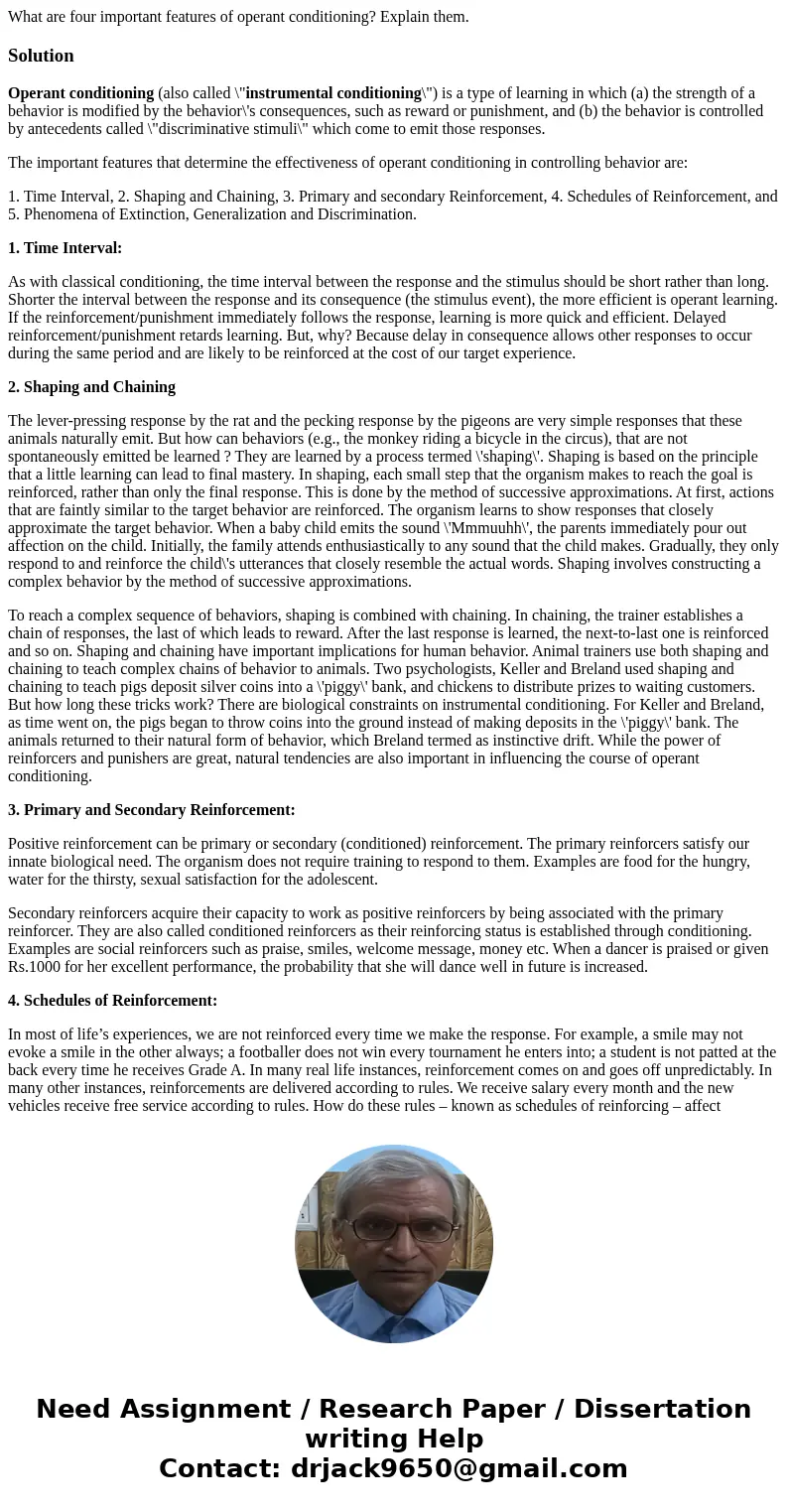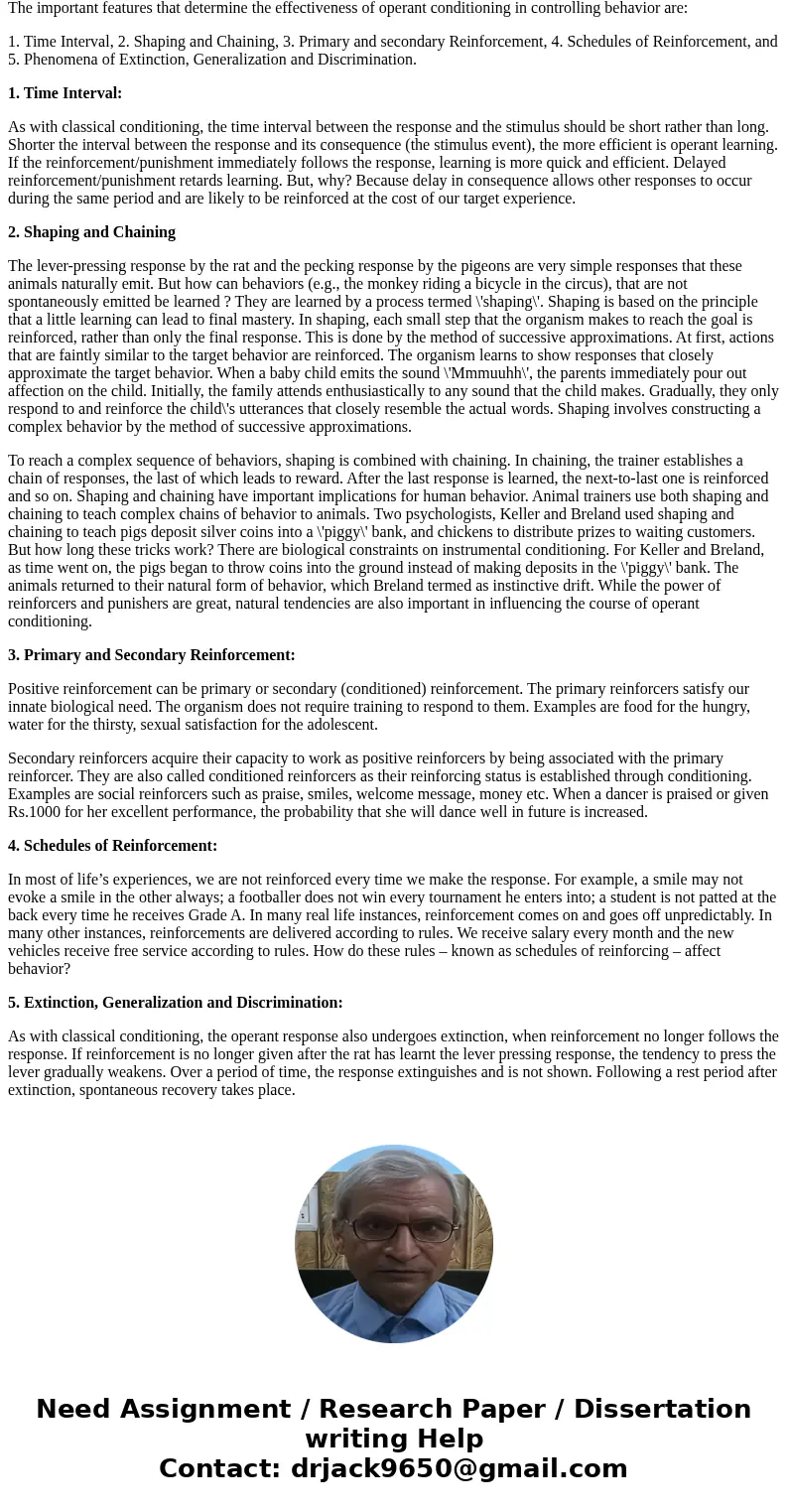What are four important features of operant conditioning Exp
What are four important features of operant conditioning? Explain them.
Solution
Operant conditioning (also called \"instrumental conditioning\") is a type of learning in which (a) the strength of a behavior is modified by the behavior\'s consequences, such as reward or punishment, and (b) the behavior is controlled by antecedents called \"discriminative stimuli\" which come to emit those responses.
The important features that determine the effectiveness of operant conditioning in controlling behavior are:
1. Time Interval, 2. Shaping and Chaining, 3. Primary and secondary Reinforcement, 4. Schedules of Reinforcement, and 5. Phenomena of Extinction, Generalization and Discrimination.
1. Time Interval:
As with classical conditioning, the time interval between the response and the stimulus should be short rather than long. Shorter the interval between the response and its consequence (the stimulus event), the more efficient is operant learning. If the reinforcement/punishment immediately follows the response, learning is more quick and efficient. Delayed reinforcement/punishment retards learning. But, why? Because delay in consequence allows other responses to occur during the same period and are likely to be reinforced at the cost of our target experience.
2. Shaping and Chaining
The lever-pressing response by the rat and the pecking response by the pigeons are very simple responses that these animals naturally emit. But how can behaviors (e.g., the monkey riding a bicycle in the circus), that are not spontaneously emitted be learned ? They are learned by a process termed \'shaping\'. Shaping is based on the principle that a little learning can lead to final mastery. In shaping, each small step that the organism makes to reach the goal is reinforced, rather than only the final response. This is done by the method of successive approximations. At first, actions that are faintly similar to the target behavior are reinforced. The organism learns to show responses that closely approximate the target behavior. When a baby child emits the sound \'Mmmuuhh\', the parents immediately pour out affection on the child. Initially, the family attends enthusiastically to any sound that the child makes. Gradually, they only respond to and reinforce the child\'s utterances that closely resemble the actual words. Shaping involves constructing a complex behavior by the method of successive approximations.
To reach a complex sequence of behaviors, shaping is combined with chaining. In chaining, the trainer establishes a chain of responses, the last of which leads to reward. After the last response is learned, the next-to-last one is reinforced and so on. Shaping and chaining have important implications for human behavior. Animal trainers use both shaping and chaining to teach complex chains of behavior to animals. Two psychologists, Keller and Breland used shaping and chaining to teach pigs deposit silver coins into a \'piggy\' bank, and chickens to distribute prizes to waiting customers. But how long these tricks work? There are biological constraints on instrumental conditioning. For Keller and Breland, as time went on, the pigs began to throw coins into the ground instead of making deposits in the \'piggy\' bank. The animals returned to their natural form of behavior, which Breland termed as instinctive drift. While the power of reinforcers and punishers are great, natural tendencies are also important in influencing the course of operant conditioning.
3. Primary and Secondary Reinforcement:
Positive reinforcement can be primary or secondary (conditioned) reinforcement. The primary reinforcers satisfy our innate biological need. The organism does not require training to respond to them. Examples are food for the hungry, water for the thirsty, sexual satisfaction for the adolescent.
Secondary reinforcers acquire their capacity to work as positive reinforcers by being associated with the primary reinforcer. They are also called conditioned reinforcers as their reinforcing status is established through conditioning. Examples are social reinforcers such as praise, smiles, welcome message, money etc. When a dancer is praised or given Rs.1000 for her excellent performance, the probability that she will dance well in future is increased.
4. Schedules of Reinforcement:
In most of life’s experiences, we are not reinforced every time we make the response. For example, a smile may not evoke a smile in the other always; a footballer does not win every tournament he enters into; a student is not patted at the back every time he receives Grade A. In many real life instances, reinforcement comes on and goes off unpredictably. In many other instances, reinforcements are delivered according to rules. We receive salary every month and the new vehicles receive free service according to rules. How do these rules – known as schedules of reinforcing – affect behavior?
5. Extinction, Generalization and Discrimination:
As with classical conditioning, the operant response also undergoes extinction, when reinforcement no longer follows the response. If reinforcement is no longer given after the rat has learnt the lever pressing response, the tendency to press the lever gradually weakens. Over a period of time, the response extinguishes and is not shown. Following a rest period after extinction, spontaneous recovery takes place.


 Homework Sourse
Homework Sourse